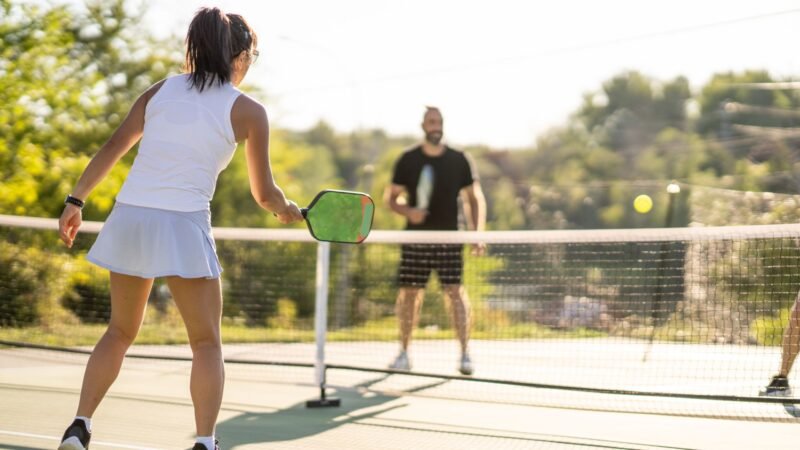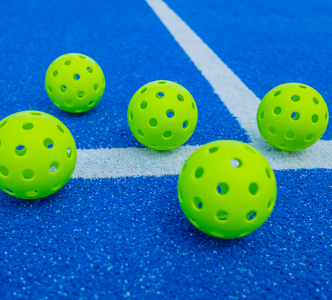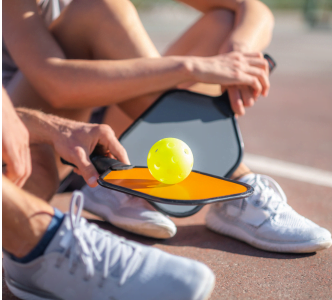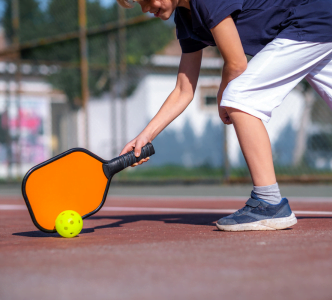The question, Can you spike in pickleball, has a clear answer. Yes, you can spike in pickleball, but knowing the rules of spiking, like where you can spike or when to spike in pickleball, is also part of this simple question because spiking is allowed with certain restrictions.
Let me share a brief overview of the spiking rules in pickleball:
- First and foremost, Spiking is not allowed in the non-volley zone, also known as (The Kitchen)
- You cannot spike as a serve.
- Players cannot touch the net or cross the centerline while spiking.
- To perform a legal spike, players must make contact with the ball above their waist and hit it downward with force.
- The spike must land within the boundaries of the court.
So now you have the 1st and second answer that you can spike in pickleball and the rules for where to spike.
But more is needed because, for the 3rd one, you should understand everything about spiking, and also, you need to learn how to spike in pickleball legally.
This guide isn’t just about teaching you to spike; it’s about transforming your entire approach to the game.
From the intricacies of pickleball’s non-volley zone rules to expert techniques and strategies that can make your spikes unstoppable.
Curious about how to make your spikes both powerful and legal? Stay with us as we uncover the secrets to spiking success in pickleball. We’re eager to hear from you in the comment after reading this, what’s your spike story?
What is Spiking in Pickleball?
Spiking in pickleball is a dynamic and powerful shot that can dramatically shift the momentum of any game. But what exactly constitutes a spike in this fast-paced sport?
Definition of a Spike
In pickleball, a spike is executed when a player hits the ball sharply and forcefully downward into the opponent’s court from an overhead position. This aggressive offensive move is typically performed when the ball is high in the air, allowing the player to strike it at a steep angle. The primary goal of a spike is to make the return by the opponent as difficult as possible, often resulting in a point due to the speed and angle of the ball making it hard to defend.
Comparison with Spikes in Other Sports

To better understand spiking in pickleball, it’s helpful to compare it with similar shots in other sports, such as volleyball.
In volleyball, a spike is also a powerful downward hit, executed after jumping and reaching above the net to slam the ball into the opponent’s court. While both sports involve a forceful downward hit, there are key differences:
- Net Height and Court Size:
- Volleyball nets are higher and courts are larger, facilitating dramatic jumps and spikes.
- Pickleball features a lower net and a smaller court, influencing the dynamics and execution of spikes.
- Non-Volley Zone (“The Kitchen”):
- Volleyball does not have a concept similar to pickleball’s non-volley zone, where players are prohibited from hitting the ball out of the air within this zone.
- This rule in pickleball significantly impacts the strategy and execution of spikes, limiting where they can be performed on the court.
- Serve and Return Rules:
- In pickleball, both the serve and the return of serve must bounce once before being hit, affecting the setup and opportunities for spiking.
- In contrast, volleyball allows for spikes to often follow a serve directly, without the requirement for the ball to bounce first.
Can You Spike in Pickleball? The Rules of Spiking

Spiking in pickleball is not only a thrilling aspect of the game but also a strategic tool that can significantly impact the outcome of a point.
However, executing a spike within the framework of pickleball’s official rules is crucial for it to be effective and legal.
Here’s a detailed look at the rules surrounding spiking and the critical role of the non-volley zone, commonly referred to as “the kitchen,” in determining when and how you can spike.
Official Pickleball Rules Regarding Spiking
Spiking is allowed in pickleball, offering players the opportunity to aggressively attack the ball. However, this must be done under specific conditions to avoid violations.
For a spike to be considered legal, one must make contact with the ball above the waist level. The waist is defined as the navel level, and this rule ensures that the action remains an overhead motion rather than a sidearm swing.
One of the most significant spiking comes from the rules governing the non-volley zone or “the kitchen.”
The Non-Volley Zone Rule (Kitchen) and Its Implications for Spiking
The non-volley zone is a seven-foot area extending from the net on both sides of the court. The primary purpose of this zone is to prevent players from executing volleys (hitting the ball in the air without letting it bounce) too close to the net, which could give them an unfair advantage.
- Spiking from the Kitchen: Players are not allowed to perform a volley, including spikes, from within the non-volley zone. This means that if you step into the kitchen or even have your momentum carry you into it after hitting the ball, your spike would be considered illegal.
- Implications for Strategy: The rule necessitates that players execute spikes from behind the non-volley zone line. This restriction adds a layer of strategic depth to the game, as players must position themselves correctly and time their spikes to ensure they do not infringe upon the kitchen rules.
- Legal Spikes and the Kitchen: A legal spike can be performed if the ball bounces first in the non-volley zone and the player spikes the ball on the bounce. However, the player must ensure they do not enter the kitchen during or immediately after the execution of the spike.
Grip Techniques for Spiking in Pickleball

In pickleball, there are three grip techniques for spiking:
- Eastern grip
- Continental grip
- Western grip
The recommended grip technique is the Western grip, which involves turning the wrist 90 degrees clockwise for righties or counterclockwise for lefties.
Eastern Grip for Power and Control
The Eastern grip, where the paddle handle lies mainly in the palm, aligning the paddle face perpendicular to the ground, is ideal for spiking. This grip allows for a balanced combination of power and control, making it easier to hit the ball downward with force while maintaining accuracy. To adopt the Eastern grip, hold your paddle as if you are shaking hands with it, ensuring your base knuckle is on the top paddle face plane.
Continental Grip for Versatility
The Continental grip, achieved by holding the paddle so that the paddle face is angled slightly towards you, offers versatility. This grip is particularly useful for players looking to switch quickly between forehand and backhand spikes without adjusting their grip significantly. It provides a stable wrist position, crucial for hitting effective spikes, especially when reacting to high balls close to the net.
Western Grip for Steep Angles
For players who prefer to impart steep angles on their spikes, the Western grip can be advantageous. This grip involves rotating the paddle further in your hand so that the paddle face tilts upward, allowing for a more pronounced wrist snap during the spike. While this grip can make controlling the spike’s direction more challenging, it is effective for aggressive players who aim to maximize the spike’s downward trajectory.
Practice Drills to Improve Your Spiking Skills

Enhancing your spiking ability in pickleball requires targeted practice. Below are drills designed to improve your spiking skills, suitable for solo practice or with a partner. These exercises focus on improving your timing, accuracy, and power, essential components of an effective spike.
Solo Drills
Wall Ball Spike Drill:
- Make a pickleball practice wall or a backboard and stand approximately 10-15 feet away.
- Toss the ball against the wall at a height above your reach, mimicking a lob.
- As the ball rebounds, position yourself and practice your spike technique, focusing on hitting the ball downward at a steep angle.
- Aim to hit specific targets or areas on the wall to improve accuracy.
High Toss and Spike:
- Toss the ball high into the air and position yourself as if you’re preparing to spike in a game.
- Practice your footwork and timing as you hit the ball on the descent, focusing on the angle and power of your spike.
- Repeat, aiming to increase consistency and control with each spike.
Partner Drills
Lob and Spike:
- With your partner, alternate between lobbing the ball and spiking.
- The lobber should aim to send the ball high enough to simulate a game-like scenario for the spiker.
- The spiker focuses on positioning, timing, and executing a powerful spike.
- Switch roles after a set number of repetitions to ensure both players practice spiking.
Defensive to Offensive Transition:
- One player starts at the baseline, and the other at the net.
- The baseline player hits a series of soft shots or dinks aiming to draw the net player into a false sense of security.
- Without warning, the baseline player lobs the ball high, setting up the net player for a spike.
- This drill helps in transitioning from defensive play to an aggressive spike.
Strategies for Spiking in Pickleball

Knowing when to spike and how to defend against spikes is crucial for leveraging this powerful shot effectively. Below, we explore strategic insights into spiking, including optimal timing, defensive maneuvers, and a case study that highlights the impact of a well-timed spike.
When to Use a Spike for Maximum Effect
The ideal time to execute a spike is when the ball is high enough in the air, giving you the leverage to hit it downward at a steep angle. This usually happens after a weak return or lob from your opponent.
If the ball bounces high in the non-volley zone and you’re positioned correctly, it’s an excellent opportunity to spike. Remember, you must let the ball bounce if you’re hitting it from the kitchen.
Use spikes to shift the momentum in your favor, especially after a series of defensive plays. A well-executed spike can energize your game and demoralize your opponents.
Defensive Strategies Against Spikes
Anticipate a spike by reading your opponent’s body language and positioning. Being ready can give you a split-second advantage to react appropriately.
Keep a balanced stance with your paddle up and in front of you, ready to block or deflect the spike. Position yourself towards the back of the court to give yourself more time to react.
When defending against a spike, use soft hands to absorb the shot’s power, allowing you to drop the ball gently over the net and into the kitchen, making it difficult for your opponent to attack again.
The Impact of a Well-Timed Spike
Scenario: In a closely contested match, both teams were locked in a defensive battle, with long rallies dominated by dinks and soft shots. The score was tied at 10-10 in a game to 11 points.
Turning Point: One team managed to force a high return from their opponents by executing a deep lob, setting up the perfect opportunity for a spike. The players at the net anticipated the high return, positioned themselves correctly outside the kitchen, and executed a powerful spike down the line, catching their opponents off guard.
Outcome: The spike was unreturnable, giving the spiking team a crucial point and the serve, shifting the momentum in their favor. They went on to win the next point and the match, demonstrating the strategic value of a well-timed spike.
Analysis: This scenario underscores the importance of strategic shot selection and positioning in pickleball. The team that won capitalized on a high return, a common setup for a spike, and executed it flawlessly under pressure. It highlights how spikes, when used judiciously, can turn the tide of a match, especially in critical moments.
Common Mistakes to Avoid When Spiking

One of the most common mistakes is improper foot positioning and body alignment. Players often underestimate the importance of positioning their feet correctly and aligning their bodies to maximize power and control.3
This misalignment can lead to spikes that are either too weak or misdirected. The correction here involves practicing footwork drills that emphasize quick, precise movements to get into the optimal position before executing a spike.
Another frequent error is hitting the ball too hard without focusing on aim or angle. While power is a significant component of an effective spike, overemphasizing force at the expense of accuracy often results in the ball going out of bounds or directly into the net.
To correct this, you should work on controlling your swing to balance power with precision. Practicing with targets or specific zones on the court can help develop a more nuanced approach to spiking, where control complements power.
Timing is also a critical aspect of spiking that many players struggle with. Misjudging the ball’s trajectory or the timing of the jump can lead to ineffective spikes or missing the ball entirely.
Improving timing starts with better anticipation and observation skills. Watching the ball closely from the moment it leaves the opponent’s paddle and practicing timed jumps and swings can enhance your ability to connect with the ball at the optimal point for a successful spike.
Lastly, neglecting the follow-through is a mistake that can rob a spike of its intended impact. A proper follow-through ensures that the power generated from the swing is fully transferred to the ball, giving it the desired speed and direction.
You should focus on completing your arm movement even after contact with the ball, aiming towards your target zone on the court. This not only increases the effectiveness of the spike but also helps maintain balance and readiness for a better spike in pickleball in the next play.
Conclusion
Mastering the art of spiking in pickleball requires understanding its rules, perfecting the technique, and avoiding common mistakes. This guide offers a comprehensive look at how to execute powerful and legal spikes, emphasizing the importance of positioning, timing, and practice drills. By focusing on these key aspects, players can elevate their pickleball game and make spiking a dynamic part of their strategy on the court.
FAQ’s
Can you slam the ball in pickleball?
Slamming the ball, commonly known as spiking, is a permitted and strategic move in pickleball to secure points. This action, however, must adhere to specific rules, notably the prohibition against performing slams from within the non-volley zone, also referred to as “the kitchen,” unless the ball has first made contact with the ground within this area.
Can you hit overhand in pickleball?
Overhand hits are allowed and are particularly common for serves and spikes. The critical factor is that the ball must be struck above the waist, defined at the level of the navel, to comply with the rules of a legal hit.
What is an illegal hit in pickleball?
Illegal hits in pickleball encompass actions such as striking the ball in the air from within the non-volley zone without it bouncing, hitting the ball twice or having it make contact with different parts of the body or paddle in a single swing, and carrying the ball with the paddle rather than striking it.
What can you not do in pickleball?
In pickleball, players are restricted from several actions to ensure fair play. Volleying the ball from within the non-volley zone without a bounce, serving from within the baseline, crossing into the opponent’s court, and any form of obstruction or intentional distraction towards the opponent are all prohibited. These rules aim to keep the game enjoyable and competitive for participants at all levels.
Can you double bounce in pickleball?
In pickleball, the ball must bounce once on each side of the net before volleys are allowed during the first two exchanges of a point, known as the double bounce rule. This rule ensures that the serving team cannot immediately volley the return of serve, promoting longer rallies and strategic play. After these initial exchanges, players may then volley the ball without it bouncing, provided they are not within the non-volley zone.







